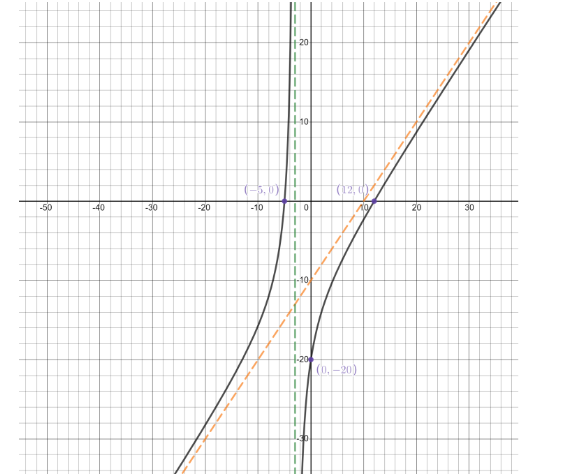Question
Question: How do you graph \( y = \dfrac{{{x^2} - 7x - 60}}{{x + 3}} \) using asymptotes, intercepts and behav...
How do you graph y=x+3x2−7x−60 using asymptotes, intercepts and behavior?
Solution
Hint : To graph the given equation, first find for asymptotes present in it find vertical asymptote and check for horizontal asymptote if it is present or not by comparing the degree of the numerator and the denominator, maybe you will get an oblique asymptote instead of a vertical one. Then find oblique asymptote by dividing or simplifying the equation. Now, find the intercepts of the graph by putting xandy values zero separately in the equation. After that, find its behavior by checking the value of the graph at positive and negative infinity. Draw the graph accordingly.
Complete step-by-step answer :
In the given equation, y=x+3x2−7x−60 we can see that the expression is not defined at x=−3 so it is the vertical asymptote of the equation.
Also the degree of the numerator is greater than that of the denominator, that means there is no horizontal asymptote and an oblique asymptote is present here.
Finding oblique asymptote by simplifying or dividing the numerator with denominator
⇒y=x+3x2−7x−60 ⇒y=x+3x2−10x+3x−30−30 ⇒y=x+3x(x−10)+3(x−10)−30 ⇒y=x+3(x+3)(x−10)−30 ⇒y=x+3(x+3)(x−10)−x+330 ⇒y=x−10−x+330
As x will tend to infinity either plus or minus, x+330→0
∴y=x−10 is an oblique asymptote.
And also if we put x=−3 in the equation, then y→−∞
∴x=−3 is a vertical asymptote.
When putting x=0 in the equation we are getting
⇒y=0−10−0+330 ⇒y=0−10−330 ⇒y=−10−10 ⇒y=−20
And at y=0,
⇒0=x−10−x+330 ⇒0=x+3(x−10)(x+3)−30 ⇒0=x+3x2−7x−60 ⇒x2−7x−60=0 ⇒x2−12x+5x−60=0 ⇒x(x−12)+5(x−12)=0 ⇒(x+5)(x−12)=0 ⇒x=−5and12
So these are intercepts of the graph.
Now,
x→±∞limy=x+3x2−7x−60=±∞
So we also get the behavior,
Graphing the equation as per the asymptotes, intercepts and its behavior, we will get

So this is the required graph of the equation, where green and orange dotted lines are vertical and oblique asymptotes respectively.
Note : To find an oblique asymptote we try to simplify the equation in such a manner that we will get a linear equation in xandy along with fractional function whose numerator is constant as in this question. Behavior of a graph is determined by finding its value at plus and minus infinity.
